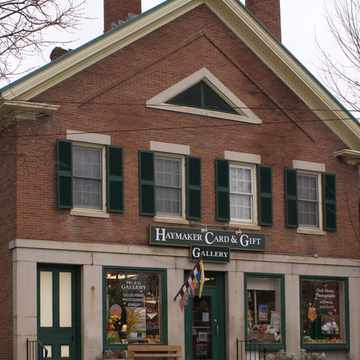You are here
“Old Morrisville” (Safford-Noyes House, Noyes House, Noyes Store, and Safford Mill and Warehouse)
A short distance west from the commercial blocks in the center of Morrisville is the heart of the original village, which retains several interrelated landmarks of the Safford and Noyes families. The brick house (1 Main Street), which is prominently sited overlooking the length of Main Street, was built about 1820 for Jedediah Safford, who continued the saw-and gristmills established by his father, John. Its fanlit central doorway, eave cornice, and gable fanlight denote its Federal origins, while its Greek Revival wood-frame rear ell and connected stable indicate that Jedediah's son John made improvements to keep it in fashion. Next door but facing east are the Greek Revival brick house and store (4 and 6 Main Street) built for David Noyes around 1840. Noyes erected a clothing mill upstream of John Safford's original 1812 mill and became the first general merchant in the growing village. Although distinguished by Ionic entrance columns, his house is otherwise a conservative central-hall type. His store, by contrast, was stylish, with a storefront divided into five bays by six massive granite piers, granite sills and lintels that trimmed the second-floor windows, and a triangular fan in the gable peak. In a prime location next to the mills, it is also the first building seen when approaching what was then known as “upper Main Street” from the south. In 1867 John Safford rebuilt his grandfather's grist-mill, behind and below the Noyes house and store on the bank of the Lamoille River at its falls. Safford trimmed it with corner pilasters, a full-eaves entablature, and an entrance surrounded by an entablature on pilasters—remarkable Greek Revival styling for an industrial structure. Nearby upstream is a similarly styled two-story, wood-frame warehouse that served the grist-and sawmills and other enterprises of J. Safford and Sons. In 1875, John Safford's son Hiram sold the family home to David Noyes's son Carlos, who continued and expanded his father's business interests in the village and added a front veranda to the house. Hiram sold the gristmill in 1899 to his competitor Henry A. Slayton, who rehabilitated it. The Safford-Noyes house is now the headquarters of the Morristown Historical Society and is open to the public periodically.
Writing Credits
If SAH Archipedia has been useful to you, please consider supporting it.
SAH Archipedia tells the story of the United States through its buildings, landscapes, and cities. This freely available resource empowers the public with authoritative knowledge that deepens their understanding and appreciation of the built environment. But the Society of Architectural Historians, which created SAH Archipedia with University of Virginia Press, needs your support to maintain the high-caliber research, writing, photography, cartography, editing, design, and programming that make SAH Archipedia a trusted online resource available to all who value the history of place, heritage tourism, and learning.


